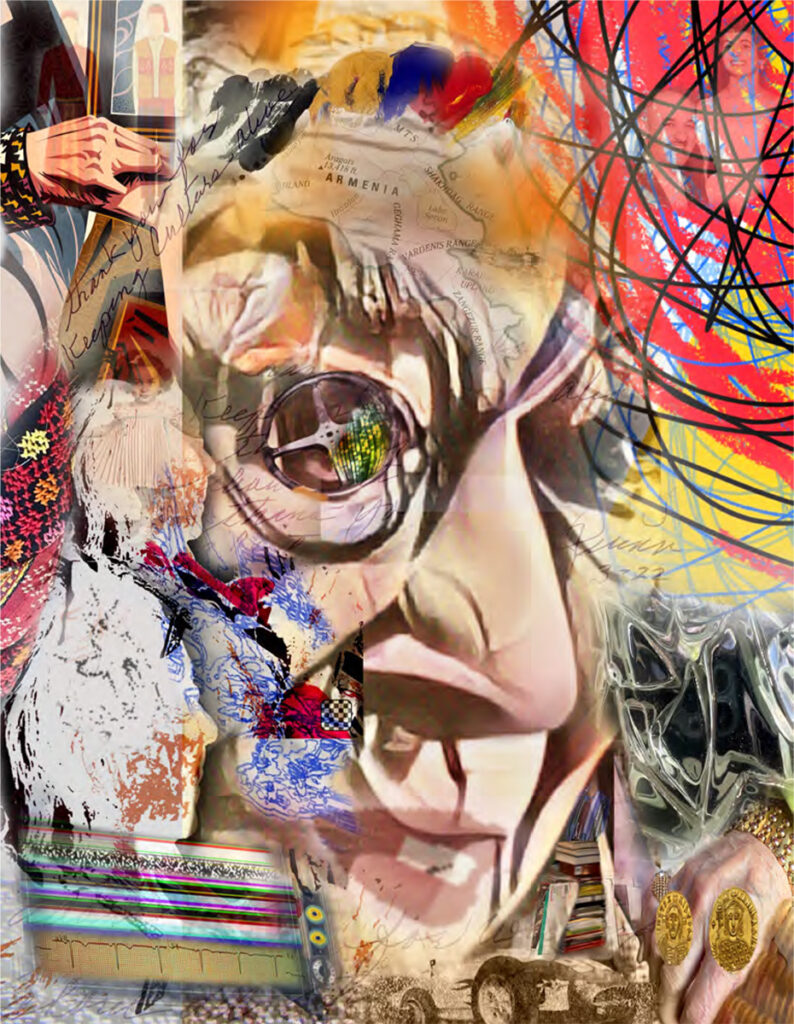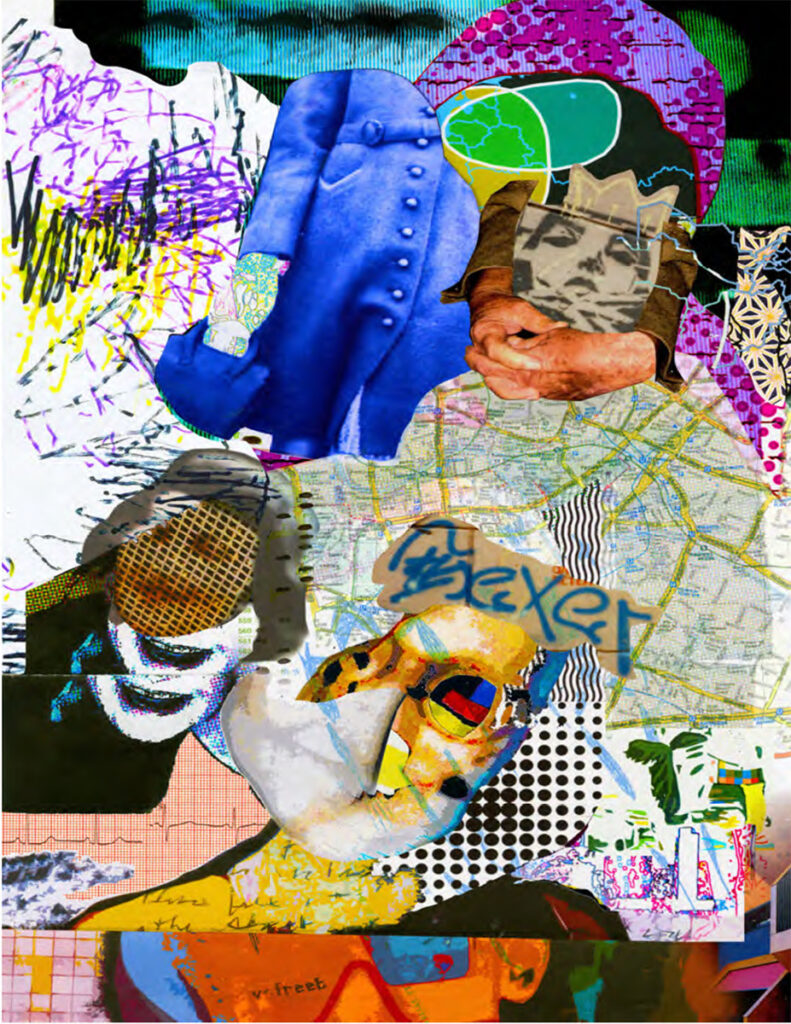
Diane Holland at Tufenkian Fine Art and Tokyo Metropolitan Museum of Art Whitehot Magazine Article by Lorien Suarez-Kanerva
Diane Holland’s photomontages are currently on display in the Winter group exhibition, which
opened on January 20th at the Tufenkian Fine Art Gallery in Glendale, California. From June 15th to 20th, her portrait of noted Los Angeles collector Joan Agajanian Quinn will be a part of “The USA Exhibition” for the 23rd Japan International Art Exchange Program, curated by Julienne Johnson in collaboration with chairman Katsu Shimmin, at the Tokyo Metropolitan Museum of Art. Holland addresses art with a faith that brings to light a greater unknown dimension yet to be discovered. In her photomontages, Holland reaches beyond her sense of self to free the meaning of identity and community. As Piet Mondrian stated, “The position of the artist is humble. He is essentially a channel.” Mondrian’s conceptual approach towards art-making reflects this vitally important understanding of Holland’s role and the nature
of her work.

Amongst the elements in her photomontages, Holland includes photographs of herself and her family. Anatomical allusions through forms like lungs, legs, and eyes speak of mankind as a human body that appears in most of her Metanoia works. “Metanoia” works. “Palimpsestic Metanoia 8” integrates maps of South Africa, a migration point for her family. Amongst these is a trace element of a WWII Star of David fabric insignia. Though faded, it remains present. Drawings of lungs in the background behind the two figures unite them through the experience of drawing breaths. Holland’s face appears in the central figure beside a focal point that extends outward into parallel slits. Window-like shapes suggest a grid of large city buildings. Chinese lanterns appear to have a universal scope as well. Their provenance could come from any western Chinatown arising from the extensive network of settlement locations.

Holland’s portrait of the iconic Joan Quinn follows the tradition of Quinn’s artist friends, who created her portrait from myriad vantages. A hundred of Quinn’s collection portraits appeared in a show at the Bakersfield Museum of Art in the fall of 2021. Quinn reflected at the time that the artworks, each focused on a single subject, were less portraits of her than self-portraits. Holland’s portrait includes a collection of visual cues to aspects of Joan Agajanian Quinn’s life story. As an Armenian-American, Quinn wore a cross and was known for her penchant for abundant and elaborate jewelry. There are references to the colors of the Armenian flag and its map. Holland includes a portion of a handwritten message from a letter thanking LA-based art critic Peter Frank for “keeping culture alive.” The note alluded to a Robert Dowd artwork titled “Cash” that caused Dowd to be arrested in 1963 on a charge of counterfeiting for painting money. Holland herself shares an affinity with the pioneering feminist photomontage artist Hanna Höch.
Additional influences include intermedia/multimedia artists William Kentridge and Lucas Samaras.

Robert Sturnam’s “Seeing Humanity” through a Photographer’s Eye aims to present an enlightening depiction of human beings while sharing images of people worldwide in meditation and yoga poses. These images convey an earnest longing that points “towards the magnificence of the human spirit.” Holland brings forward with Sternum and with movement-dance pioneer Emilie Conrad a practice with somatic motion that, like yoga, allows for an essential form of open awareness that facilitates communication towards a greater community. In Hanna Heiting’s film “Em Moves,” Conrad describes a pivotal premise to the foundational ethos of her Continuum movement:
The fractal dimension of the umbilical cord is [shared with] that fluid [dimension] in the galaxy, planets and our body that functions as a resonant stream of bio-cosmic intelligence and it is primary nourishment. By engaging in fluid movement the universe communicates to us through our fluid motion, the universes’ wave motion which has a moving language. Through undulations, spirals and pulsations – the fundamental choreography of water…allows our tissue to become less encumbered so that that choreography can reveal itself.
An innate organic form of transrational breathing alongside fluid physical movements frees participants from stresses and disenchantments, leading towards freedom and a sense of openness.

From an excerpt about “Aging” in the video “Continuum: A Conversation” with Emilie Conrad, the late Dr. Valerie V. Hunt, an American scientist and professor of Physiological Science at UCLA, described somatic movement in the following terms:
“Now we realize the body has the ability to move in all planes and in all directions. No muscle has a single function. It has a combined function. It must participate with all other muscles to have health. When you see small children hanging, you wonder why they are so free. Well they’ve been free in the amniotic fluid. [Somatic movement] is like going back to being free.”
Studying with Conrad, Holland shared her practice of somatic movements, something akin to a ritual practice of vocalizations and unchoreographed fluid movements of limbs and torso, all while lying prone. In this free-flow state, Holland turns to a form of physical meditation to reach higher consciousness. Then, when she engages with her media, she cuts, pastes, arranges, and rearranges paper and photographs to assemble a singular visual composition.
As the artist describes, “‘Palimpsestic Metanoia’ works translate personal experience into imagery that is at once digital and painterly. The source material for electrostatic and photographic composite alike is drawn from real and imagined experience and engage a collage aesthetic appropriate to the multivalent sensory possibilities of our time.”
Holland’s video “Letting Go, One Frame at a Time” allows her photomontage work to follow a sequence of scenes where the elements acquire a tangible voice. Her spoken words of inquiry serve as a form of self-de-entanglement and explore what it means to be human.
Video link: https://youtu.be/mIhkhOUvK8s?si=oz9N6dE_NGhZeUpF












